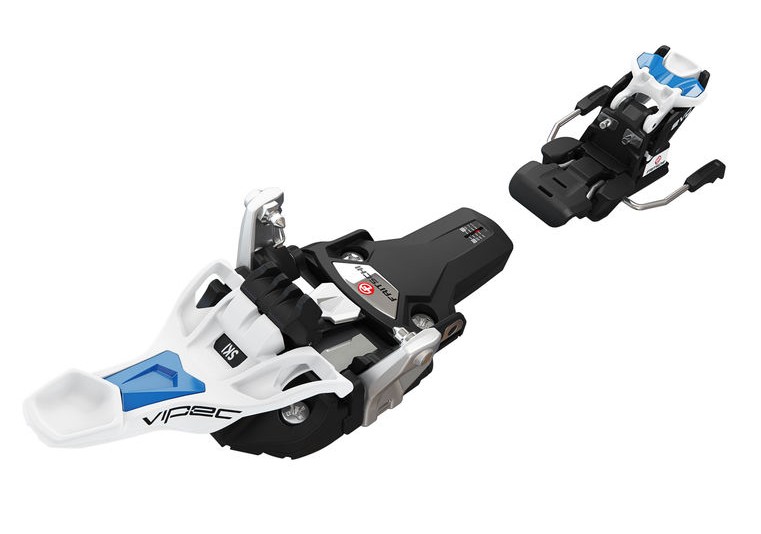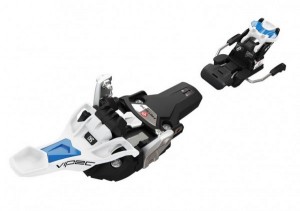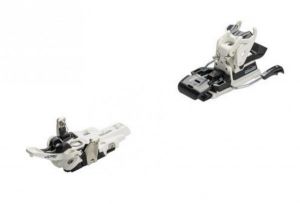The Fritschi Vipec AT binding is replaced by the updated Fritschi Vipec EVO 12, pictured above. Details on the evolution of this product below!
Fritschi Vipec EVO 12 Review
Our Verdict
The Fritschi Vipec AT binding is replaced by the updated Fritschi Vipec EVO 12, pictured above. Details on the evolution of this product below!
Our Analysis and Test Results
The Evolution of the Vipec
Fritschi replaced the original Vipec AT binding with the Vipec 12 TUV, which is now replaced by another iteration - the Vipec EVO 12. Check out a side-by-side comparison of the two bindings below, with the Vipec EVO on the left, and the original version we tested on the right.
Here's a summary of the updates:
Vipec 12 TUV
- Toepiece — Redesigned toepiece for easier step-in and TUV certification for safety release.
Vipec EVO 12
- Toepiece — Yet another redesign of the toepiece for improved step-in, this time utilizing a bumper guide.
- New Graphics — The Vipec EVO 12 now features a sleek logo with white, blue, and black color scheme.
Although we have not yet tested the Fritschi Vipec EVO 12, we are curious to verify the manufacturer's claims of significant improvement to the toe piece. For now, the review below reflects the original version of the Vipec binding.
Hands-on Review of the Fritschi Vipec AT
Ease of Use
While the Vipec has many advantages, ease of stepping into the toe piece is not one of them. Even after four days of use, our testers found this model more challenging to get into than the Dynafit Radical ST 2.0, G3 ION 12, or Marker Kingpin 13. Its spring loaded toe too easily misalignes with the user's boot, closing shut prematurely. This is especially evident when trying to use more traditional techniques, which are commonly used when stepping into a tech style binding toe piece. We do recognize that all alpine touring bindings have their quirks, and we found that if we set our heel above the pins on the rear part of the binding, this set us up for the perfect distance for the front pin holes of our boot, and we were more likely to get it first try.
While skinning uphill, our testers sometimes experienced a small inconvenience: the brakes suddenly deploying. This was certainly more problematic on wetter days (where icing was more of an issue). It never proved to be a permanent issue; just a slight pain to re-engage the brake into touring mode.
Touring Performance
This contender offers slightly above-average overall touring performance. This model offers all the same benefits as other tech bindings with efficient stride, and is the lightest tech binding to receive the ISO/DIN certification. This binding's heel risers are among the easiest to engage and disengage, and its relatively low weight and ease-to-transition design make this competitor a solid touring binding.
Transitions
To transition this contender from ski touring mode to downhill mode, you must flip a black lever on the back of the binding upwards; this can be done with a little above-average force via a ski pole, or easily with your hand. We found the transition much easier than the Kingpin 13, which took more force and was more prone to icing. A sweet feature of this model is how easily you can transition back to touring from downhill mode. Our testers found this especially useful when using "Nordic Mode" (a term many backcountry tourers use to describe traveling on relatively level ground with heels free, but no skins).
Downhill Performance
We really liked the overall downhill performance; this model hit a nice balance between weight, energy transfer, and skier safety. A unique feature of this binding is it's the only tech binding to feature an adjustable DIN setting (to adjust the release value) in the toe and the heel of the binding. All other tech bindings merely feature two adjustable heel DIN settings (one for vertical release and the other for lateral), but the toe remains set. Another safety-oriented feature is its 13 mm of lateral travel in the toe piece and independent toe prongs that allow a skier to be released (or retained) over a greater array of fall angles and possibilities.
All of these factors helped this contender become one of the earlier tech bindings to receive the TUV's ISO/DIN certification for skier safety and consistency in release values; our testers appreciated the particularly low 5 mm of ramp angle. This competitor skied downhill as good or better than most touring bindings, performing better on the descent than the G3 ION 12, around the same as the Dynafit Radical ST 2.0 and the Dynafit Beast 16, and close (but maybe not quite) in performance to the Marker Kingpin 13.
Durability
This model is a durable binding that provides confidence when touring deep into the backcountry in remote locations. After talking with several backcountry shops, AMGA and ACMG ski guides, and outdoor retail sales reps, we feel this competitor offers comparable durability to the G3 ION 12, and is likely very near as durable as the Dynafit Radical 2.0.
Weight
These bindings weigh in at 1090 g (2 lb 1 oz) per pair, which is around half a pound lighter than the Dynafit Radical 2.0 or G3 ION 12 (both 2 lbs 9 oz per pair), and over a pound lighter than the Marker KingPin (3 lbs 4 oz/1460 g). With that being said, this model doesn't give up much for its lighter weight.
Other Features
There is no standardization among where the pins "have" to fit on a boot; while the ski-touring industry is moving towards this, not all boots will fit as well as others will into a given binding's pins. Fritschi has attempted to overcome this with adjustable pin lengths to help achieve a better fit with any given boot, thus resulting in better downhill performance. Fritschi had some issues with their pins falling out of their bindings, but this was more a result of the glue that Fritschi bought to use on their bindings rather than a design flaw. They quickly fixed this problem and the newer bindings don't appear to have this same issue.
Best Applications
This is a super capable touring binding that will perform fine, but not amazingly, for in-bounds adventures. We'd highly recommend it for touring, but if you plan on riding chairs for more than 50% of your ski days, this pair of bindings isn't nearly as nice to ski as the beefier AT bindings, such as the Marker Baron 13 EPF, Marker Duke, or Fritschi Freeride Pro.
Value and the Bottom Line
Price-wise, this binding is in line with most other touring bindings. Compared to the Radical ST 2.0 and the ION, you save nearly half a pound of weight. The Vipec offers the fairly unique ability to adjust the release values of both the toe and the heel, rather than most tech style bindings only offering heel release value adjustment.
Conclusion
The Vipec is one of the safer tech style touring bindings on the market, with remarkably good downhill performance. They are one of our tester's favorite pair of touring bindings and have a lot of positive qualities. However, their downfall is that the toe piece takes a little getting used to as far as entry goes.






